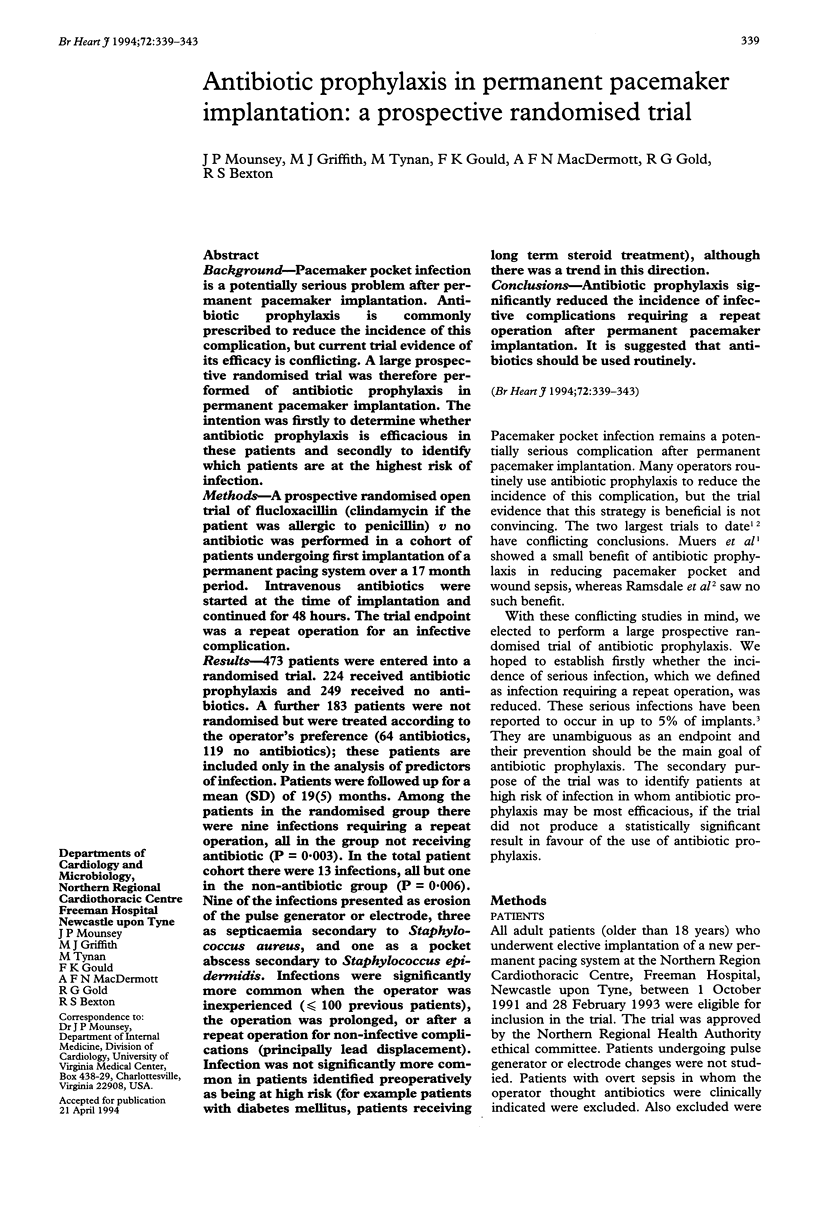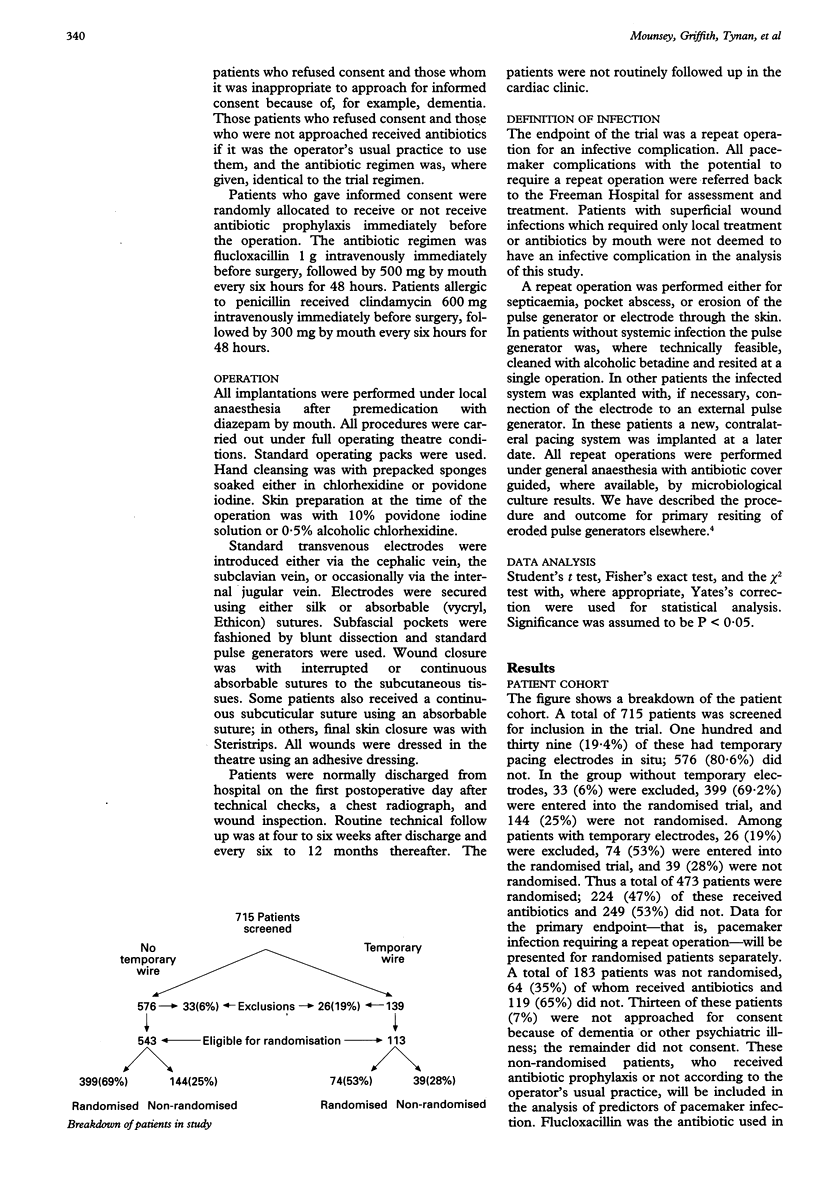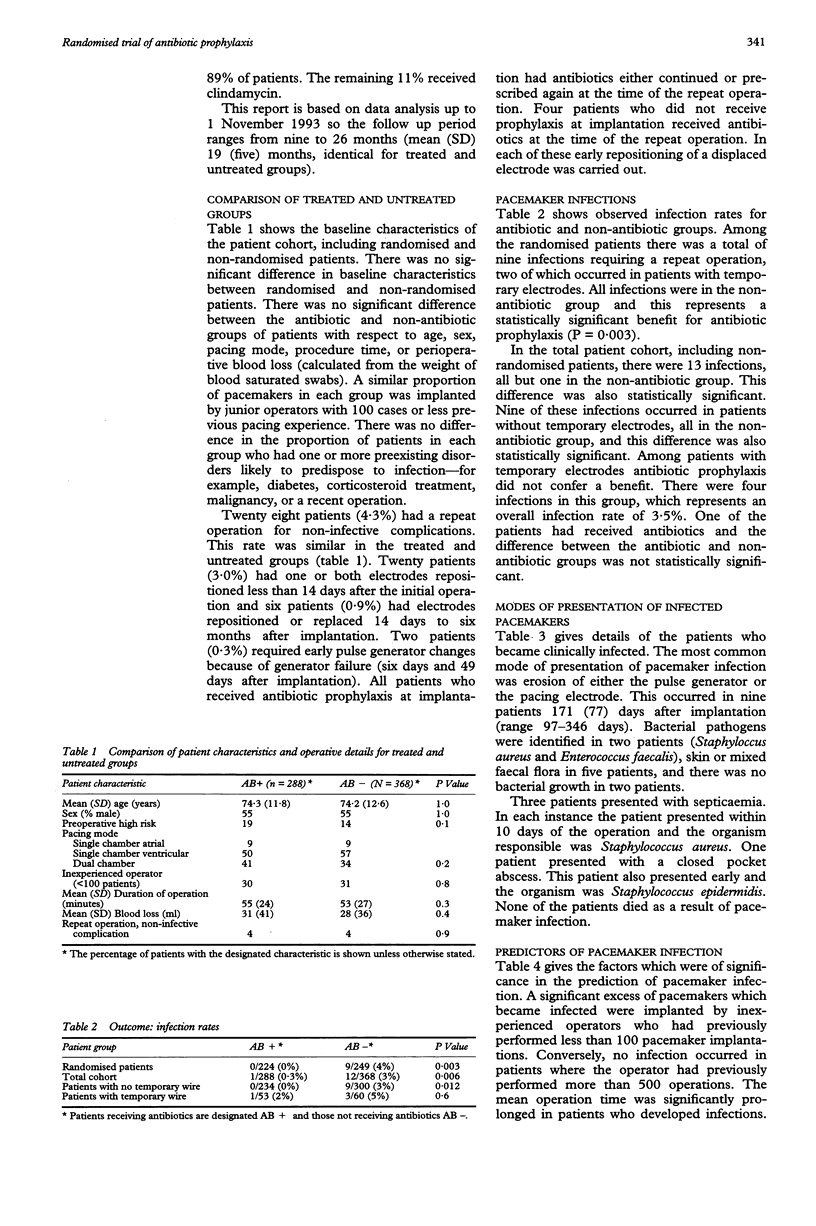Abstract
BACKGROUND--Pacemaker pocket infection is a potentially serious problem after permanent pacemaker implantation. Antibiotic prophylaxis is commonly prescribed to reduce the incidence of this complication, but current trial evidence of its efficacy is conflicting. A large prospective randomised trial was therefore performed of antibiotic prophylaxis in permanent pacemaker implantation. The intention was firstly to determine whether antibiotic prophylaxis is efficacious in these patients and secondly to identify which patients are at the highest risk of infection. METHODS--A prospective randomised open trial of flucloxacillin (clindamycin if the patient was allergic to penicillin) v no antibiotic was performed in a cohort of patients undergoing first implantation of a permanent pacing system over a 17 month period. Intravenous antibiotics were started at the time of implantation and continued for 48 hours. The trial endpoint was a repeat operation for an infective complication. RESULTS--473 patients were entered into a randomised trial. 224 received antibiotic prophylaxis and 249 received no antibiotics. A further 183 patients were not randomised but were treated according to the operator's preference (64 antibiotics, 119 no antibiotics); these patients are included only in the analysis of predictors of infection. Patients were followed up for a mean (SD) of 19(5) months. Among the patients in the randomised group there were nine infections requiring a repeat operation, all in the group not receiving antibiotic (P = 0.003). In the total patient cohort there were 13 infections, all but one in the non-antibiotic group (P = 0.006). Nine of the infections presented as erosion of the pulse generator or electrode, three as septicaemia secondary to Staphylococcus aureus, and one as a pocket abscess secondary to Staphylococcus epidermidis. Infections were significantly more common when the operator was inexperienced (< or = 100 previous patients), the operation was prolonged, or after a repeat operation for non-infective complications (principally lead displacement). Infection was not significantly more common in patients identified preoperatively as being at high risk (for example patients with diabetes mellitus, patients receiving long term steroid treatment), although there was a trend in this direction. CONCLUSIONS--Antibiotic prophylaxis significantly reduced the incidence of infective complications requiring a repeat operation after permanent pacemaker implantation. It is suggested that antibiotics should be used routinely.
Full text
PDF




Selected References
These references are in PubMed. This may not be the complete list of references from this article.
- Bluhm G., Jacobson B., Julander I., Levander-Lindgren M., Olin C. Antibiotic prophylaxis in pacemaker surgery--a prospective study. Scand J Thorac Cardiovasc Surg. 1984;18(3):227–234. doi: 10.3109/14017438409109896. [DOI] [PubMed] [Google Scholar]
- Bluhm G., Nordlander R., Ransjö U. Antibiotic prophylaxis in pacemaker surgery: a prospective double blind trial with systemic administration of antibiotic versus placebo at implantation of cardiac pacemakers. Pacing Clin Electrophysiol. 1986 Sep;9(5):720–726. doi: 10.1111/j.1540-8159.1986.tb05421.x. [DOI] [PubMed] [Google Scholar]
- Griffith M. J., Mounsey J. P., Bexton R. S., Holden M. P. Mechanical, but not infective, pacemaker erosion may be successfully managed by re-implantation of pacemakers. Br Heart J. 1994 Feb;71(2):202–205. doi: 10.1136/hrt.71.2.202. [DOI] [PMC free article] [PubMed] [Google Scholar]
- Lumia F. J., Rios J. C. Temporary transvenous pacemaker therapy: an analysis of complications. Chest. 1973 Nov;64(5):604–608. doi: 10.1378/chest.64.5.604. [DOI] [PubMed] [Google Scholar]
- Morgan G., Ginks W., Siddons H., Leatham A. Septicemia in patients with an endocardial pacemaker. Am J Cardiol. 1979 Aug;44(2):221–224. doi: 10.1016/0002-9149(79)90308-4. [DOI] [PubMed] [Google Scholar]
- Muers M. F., Arnold A. G., Sleight P. Prophylactic antibiotics for cardiac pacemaker implantation. A prospective trail. Br Heart J. 1981 Nov;46(5):539–544. doi: 10.1136/hrt.46.5.539. [DOI] [PMC free article] [PubMed] [Google Scholar]
- Ramsdale D. R., Charles R. G., Rowlands D. B., Singh S. S., Gautam P. C., Faragher E. B. Antibiotic prophylaxis for pacemaker implantation: a prospective randomized trial. Pacing Clin Electrophysiol. 1984 Sep;7(5):844–849. doi: 10.1111/j.1540-8159.1984.tb05626.x. [DOI] [PubMed] [Google Scholar]
- Wohl B., Peters R. W., Carliner N., Plotnick G., Fisher M. Late unheralded pacemaker pocket infection due to Staphylococcus epidermidis: a new clinical entity. Pacing Clin Electrophysiol. 1982 Mar;5(2):190–195. doi: 10.1111/j.1540-8159.1982.tb02213.x. [DOI] [PubMed] [Google Scholar]


